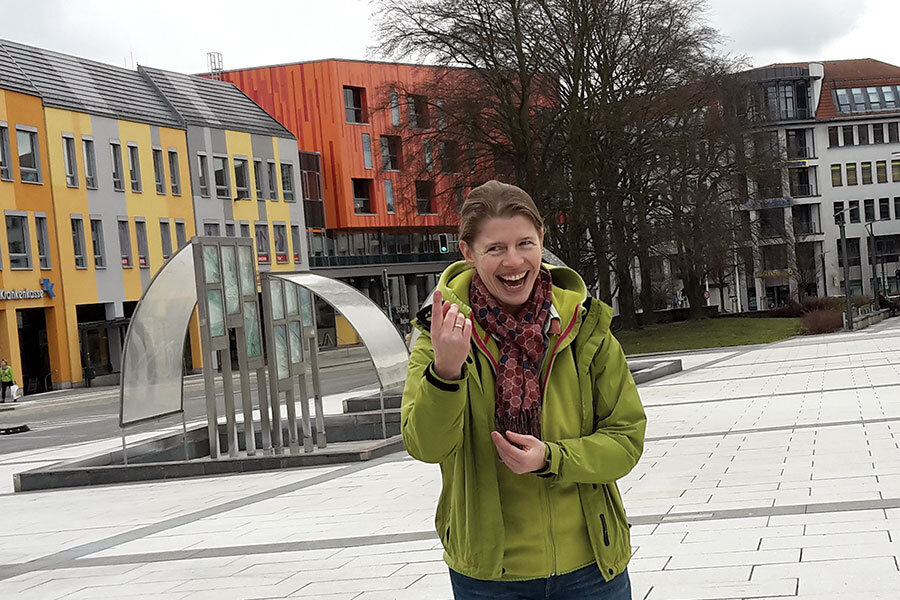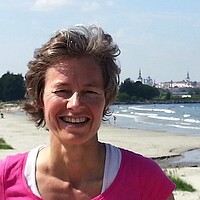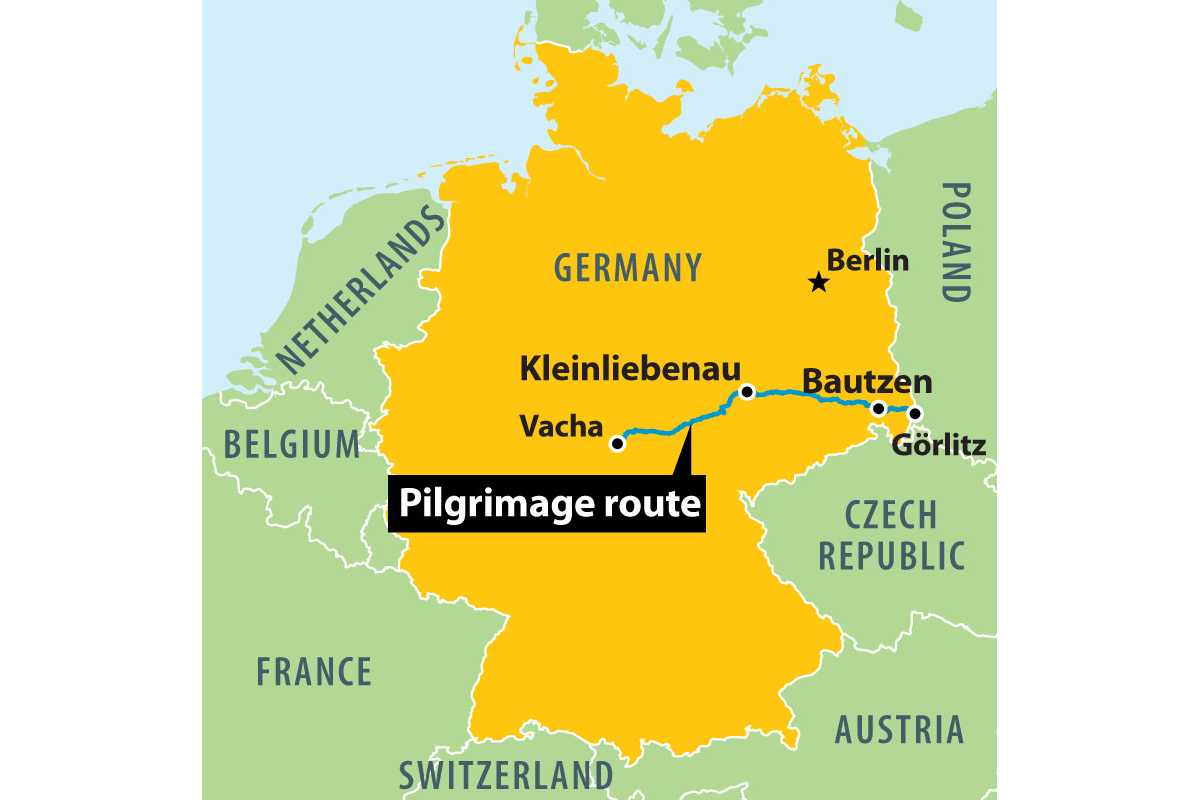She re-created a medieval trail in Germany, drawing thousands of hikers
Loading...
| Kleinliebenau and Bautzen, Germany
It had been more than six decades – 60 long years – since Erhard Zeinert last pulled the ropes that rang the bells of his village church. He was only 6 years old then. But he always remembered the sound of the bells, just as he remembered World War II, communism, the Berlin Wall, the closing of his little wooden 12th-century church and its falling into disrepair.
But those sad recollections began to fade when a young theology student arrived, ready to share her dreams with the 130 inhabitants of this rural hamlet, Kleinliebenau, as well as with others living in this region of Germany. Esther Zeiher had, accidentally, come across an old map of Europe. It showed the Via Regia, a medieval commerce and pilgrimage trail that wound its way through Germany, among other countries. Modern pilgrims had long followed the Way of St. James in France and Spain. But the old route in her region – the German state of Saxony – had been forgotten. Ms. Zeiher thought: Pilgrims could, should walk it again.
Thus began her task of reconstructing the trail – in particular, finding out who would be willing to provide space for pilgrims in need of rest and food. Kleinliebenau responded by moving to restore, and reopen, the tiny church. And so a few years ago, Mr. Zeinert got to pull the ropes of the bells again, this time to mark the church’s new life as a pilgrim shelter.
“The whole village has come back to life,” he said recently, raking the leaves of the church property. Last year, 300 pilgrims spent the night in the church.
Today, Kleinliebenau is a dot on Zeiher’s “Ecumenical Pilgrims’ Way Through Saxony, Saxony-Anhalt, and Thuringia.” It stretches from Görlitz, Germany’s easternmost town, to Vacha, in the area closest to Germany’s former West. It winds for more than 250 miles through fields and vineyards, through towns that Martin Luther preached in and Bach played in, through regions scarred by old polluting factories and the loss of their youngest residents.
And yet the trail is much more than that. Its re-creator, now a teacher in Bavaria, calls it an “adventure in humanity.” At a time when there are strong anti-refugee feelings in these parts, the route is enabling meaningful exchanges between people. It is making “strangers” seem not so strange, and in the process connecting people from Germany’s eastern and western regions. Last year alone, at least 1,500 pilgrims walked the trail.
“It’s become a place of encounter and exchange,” Zeiher says. “When people from the West and the East start sharing their stories, many of the negative feelings associated with the fall of the wall start disintegrating.”
Germany has lots of hiking trails, but with Zeiher’s route, pilgrims will always find shelter, for only a token fee – in a spare bedroom, an empty school, or a hitherto decaying church, says Volker Schikowsky, a regional planning official in Merseburg, in Saxony-Anhalt. “Esther rekindled a wonderful, age-old concept of humility, of knowing how to give and take,” he says.
The decade after communism’s collapse
Zeiher discovered the allure of hiking after graduating from high school. It was the decade after communism had collapsed, and people were struggling to get their bearings in a reunited Germany. Her father, a youth pastor, had seen two of his five children sent to jail for opposing the socialist regime. “I’d been brought up a Christian, but what did it mean for me?” she asked.
She searched for answers by hiking through Germany for a year, alone. The beauty and variety of the landscapes stunned her. “If you’re traveling by foot, you discover that intensively,” says Zeiher, now a mother of two young children.
It was a year later, on a university break, that she was walking the Way of St. James in Spain and found the map. Her mission became clear.
In 2003, she formally inaugurated the route. That was after she spent two years getting historians to help her retrace the old Via Regia, persuading officials to give her the necessary permits, and gathering volunteers to help place 15,000 blue-and-yellow “Way of St. James” scallop shell signs. Also with the help of volunteers, Zeiher had persuaded people to open their homes so there were 50 places where people could spend the night. (Now there are 100.)
Almost three decades after the Berlin Wall fell, Germany’s eastern regions haven’t yet recovered from the drain of their youngest, most educated residents and the closure of hundreds of inefficient factories. Zeiher’s pilgrimage route is helping bring Germany’s “two halves” closer together, then-German President Horst Köhler said when he awarded Zeiher the Medal of Merit in 2005.
“Esther has spurred initiatives to get people to travel, not just with their feet but also with their minds,” says Henrik Mroska, a teacher who spearheaded the effort that led to the Kleinliebenau church’s reopening. In the eastern regions, people aren’t used to dealing with foreigners, but the passing through of workers and pilgrims has helped residents see newcomers “not as strangers, but as human beings.”
Pilgrims popping up in the backyard
In the town of Glaubitz, Sandra Werner’s four children say “they’re coming!” when pilgrims pop up in their backyard. The youths have learned how to ask questions of the visitors and find out about other places in the world. “At work people tell me, ‘How can you let strangers in your house?’ ” says Ms. Werner, a professional gardener. Her answer: Being a “pilgrim mother” has taught her about “humanity, warmth, giving.”
Matthias Sengewald, a deacon and youth worker in Erfurt, sees larger benefits from the exchanges. “When you ... can open yourself to newcomers, then it becomes less difficult to deal with refugees,” says Mr. Sengewald, who was a figure in helping to bring down communism.
Walking Zeiher’s pilgrimage route helped Gert and Andrea Kleinsteuber of Schkeuditz, a village near Leipzig, overcome the loss they felt after Germany’s reunification. In the old East Germany, they’d been convinced socialist citizens, and when the Berlin Wall fell, it was also their beliefs, their lives, that shattered. They longed for the community feeling that the old system had given them. Walking the Way of St. James first, and then Zeiher’s trail recently, helped them reconnect with their country and its people. Now, every few Sundays they drive to Kleinliebenau to bring coffee and cake to the pilgrims.
“Maybe we’d still be as bitter as some of our friends if we hadn’t walked hundreds of miles and met so many different people,” says Mr. Kleinsteuber, now a police officer in Leipzig.
But re-creating the pilgrimage route was an uphill battle. When Zeiher knocked on his door, “I thought she was an incredibly naive young woman,” recalls Mr. Schikowsky, the planning official. “But her idea wasn’t naive: It was brilliant.”
Historians were skeptical, too. While for centuries, Roman Catholic pilgrims had been making the sacred St. James journey for heavenly rewards, Luther considered pilgrimages heresy. “Why on earth do you want to do a Catholic pilgrimage in the heart of a Protestant country?” Zeiher remembers one historian asking. “I told him that walking the route could have a wake-up function,” she says. It “could help people develop trust – in their own strength, in others, in God.”
‘We’re here to tell a different story’
On a recent Saturday, Zeiher and 60 volunteers gathered in the town of Bautzen to share stories and brainstorm about the future of the route. Bautzen attracted headlines last year after a planned refugee center went up in flames and neo-Nazi groups marched through the town. “But we’re here to tell a different story,” Zeiher says.
One route volunteer is Monika Gerdes. Her home in Crostwitz, near Bautzen, has a big world map with colorful pins showing where the 280 pilgrims who stayed with her last year call home. She also has a guest book filled with words of thanks and stories.
“With each pilgrim, it’s a bit of the world that’s coming to me!” says Ms. Gerdes, a public radio reporter covering the Sorbian community, an ethnic group. “We learn to let go – of our time, our fears.”
That is the gift of Zeiher’s project.
How to take action
UniversalGiving helps people give to and volunteer for top-performing charitable organizations around the world. All the projects are vetted by UniversalGiving; 100 percent of each donation goes directly to the listed cause. Below are links to three groups supporting educational or social causes or both:
Literacy Partners has a two-generation approach to education that includes free classes for low-income parents in New York to work on their literacy and language skills. Take action: Volunteer at this organization’s office.
Miracles in Action provides Guatemalans living in extreme poverty with opportunities to help themselves through sustainable development projects. Take action: Buy books for students.
Highland Support Project works with community leaders to address environmental, social, and economic challenges. Take action: Make a donation to this organization.









